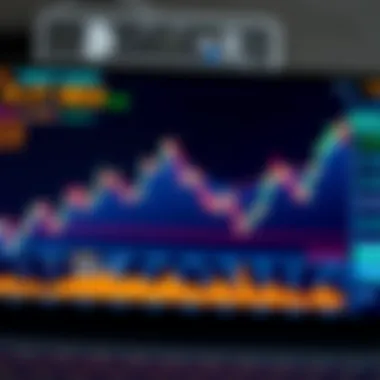Mastering Trading Charts: The Essential Guide


Intro
Trading charts are the lifeblood of financial markets, acting as both a compass and a map for traders. Understanding these graphs is like learning another language, one that can unlock profitable insights and strategies. The art of trading isn't just about gut feelings; it relies heavily on data—data that is visualized through these charts. This guide aims to unravel the intricate components that make up trading charts, diving into varied types and the essential skills you’ll need to interpret them rightly.
Charts don't merely show price movements; they can also tell you about market sentiment. This guide is crafted for everyone—whether you're a trader new to the scene or someone with years of experience looking to refine your analysis skills.
Let's journey through the fascinating realm of trading charts and discover how they can pave the way to smarter trading strategies.
Prelude to Trading Charts
In the complex realm of trading, charts serve as essential navigational tools, guiding traders through the ups and downs of market movements. Just like sailors rely on their maps to steer through tumultuous waters, traders rely on charts to make sense of price fluctuations and market trends. Understanding trading charts is not just a beneficial skill, it’s an indispensable part of executing effective trading strategies.
Definition and Importance
A trading chart is a visual representation of historical price movements over time. It reflects the price action of securities, commodities, or any asset, encapsulated neatly in a format that can be quickly analyzed. The significance of trading charts cannot be overstated. They provide a snapshot of a market's performance, revealing patterns and trends that traders can utilize to forecast future behavior.
The importance lies in various elements:
- Visual Clarity: Charts translate raw data into a digestible format, allowing traders to analyze data that could otherwise be overwhelming if presented in numbers.
- Trend Identification: Investors can spot bullish and bearish trends, which guide their decision-making for buying or selling.
- Pattern Recognition: Many traders rely on recognizable patterns that have historically indicated market outcomes. Identifying these can facilitate better trades.
Ultimately, mastering trading charts allows traders to make well-informed decisions, minimizing risks and maximizing potential returns. Without this foundational understanding, navigating the trading landscape can be a perilous endeavor.
A Brief History of Charting
Charting as a practice dates back to the 17th century, originating in Japan when rice traders used candlestick charts to track rice prices. This method integrated visual elements into trading, paving the path for the sophisticated techniques we see today in the financial markets.
As the centuries passed, charting techniques evolved. In the 1920s, Charles Dow further solidified the use of charts for market analysis with his Dow Theory, suggesting that stock price movements reflect the collective sentiment of investors. It wasn't until the invention of computers that charting became widely accessible. Nowadays, sophisticated software allows for advanced chart types and indicators, revolutionizing trading.
Understanding the historical evolution of charting illuminates its significance and provides context for its current applications in modern trading methodologies. Today's traders benefit from centuries of accumulated wisdom in chart analysis, making it a living testament to the importance of adapting and learning in the financial markets.
Types of Trading Charts
When it comes to trading, being able to interpret charts is as crucial as knowing the ins and outs of market trends. Trading charts serve as visual representations of price movements over time. They play a fundamental role in helping traders make informed decisions. Charts delineate the fluctuations in price and offer insights into past performances, trends, and potential future movements. In this section, we will explore various types of trading charts: each has its unique features and advantages that cater to different trading strategies and styles.
Line Charts
Line charts are one of the most straightforward ways to visualize price movements. They can be easily understood, even by those new to trading. By connecting closing prices at designated intervals, you can quickly grasp the overall trend of an asset. The simplicity of line charts allows traders to identify shifts in momentum without the distraction of excessive details. It’s an excellent tool for spotting general trends or determining whether a security is moving upward or downward over a specified period.
Their primary strength lies in clarity; however, they may lack some depth regarding market activity during the trading intervals, which might miss out on significant fluctuations that occur between closing prices.
Bar Charts
Bar charts present a more detailed narrative about price action. Each bar conveys four essential pieces of information: the open, high, low, and close prices for a specified time frame. This richer data set provides traders with insight into market volatility and price ranges.
The height of each bar offers quick visual cues regarding trends. A taller bar might indicate strong market movement, while shorter bars suggest lower volatility. Although bar charts provide a more robust picture than line charts, they can be a bit intimidating for beginners, as they require an understanding of this more complex data representation.
Candlestick Charts
Candlestick charts are akin to bar charts but present information in a visually engaging format. Each candlestick details the same four price points as bar charts but does so in a more visually appealing way. The body of the candlestick signifies the range between the opening and closing prices, while the wicks represent the high and low prices within that time frame. Traders favor candlestick charts for their ability to convey information at a glance.
Understanding Candlestick Anatomy
Understanding the anatomy of a candlestick is vital for any trader. Each candlestick has a body and two wicks. The body’s color indicates whether the closing price was higher or lower than the opening price. A green (or white) body shows that the price closed higher, while a red (or black) body indicates a drop.
This visual representation helps in quickly gauging market sentiment. Trends can be swiftly discerned, enabling traders to spot potential trade opportunities based on how each candlestick forms in relation to others around it. The ability to visually assess market psychology makes candlestick patterns a particularly powerful tool.
Types of Candlestick Patterns
Candlestick patterns reveal critical market signals that can help traders anticipate future movements. There are numerous well-known patterns that traders often look for:
- Bullish Engulfing: Suggests a potential upward trend following a bearish period.
- Bearish Engulfing: Indicates a potential downward trend following bullish movements.
- Doji: Represents market indecision, often signaling potential reversals.
By mastering these patterns, traders increase their arsenal of tools for making educated decisions. One anchor point to remember is that these patterns, while helpful, should not be used in isolation; they work best in conjunction with other indicators and chart data.
Area Charts
Area charts are another form of data visualization, similar to line charts but with shaded areas beneath the line. They can provide a clear perspective on the magnitude of price movements over time. This overlap may assist in visualizing cumulative data or comparing two different financial instruments over the same period. While they are visually compelling, they can muddy the waters if one is seeking precise price information.
Renko and Point-and-Figure Charts
Renko charts focus on price movement rather than time, filtering out the noise caused by time frames. Each block indicates a set price movement, which can help in highlighting the prevailing trend without the interruptions of time intervals.


Point-and-figure charts, like Renko, also disregard time but emphasize price movements and reversals. They use X's and O's to signify upward and downward movements, respectively. This method is also beneficial for identifying support and resistance levels clearly. Though they may seem less conventional, they cater to traders who prefer a more price-focused approach and can prove instrumental in clarifying market trends without the distractions of volatility.
In summary, different types of trading charts cater to various analytical needs, providing traders with the ability to perceive market movements through distinct lenses. Each type adds its layer of understanding, making it crucial for traders to choose the chart that aligns best with their strategies and trading styles.
Key Components of Trading Charts
Understanding trading charts is not just about recognizing shapes and colors; it's about grasping how these elements work together to tell a story about the market's movements. A trading chart might look like just a jumble of lines, but within that complexity lies crucial information that traders use to make informed decisions. The key components of trading charts serve as building blocks that traders lean on. Mastering them often leads to enhanced analytical skills, allowing traders to navigate market fluctuations with more confidence.
Price Axis and Time Axis
In most trading charts, the vertical line represents the price while the horizontal line depicts time. Essentially, the price axis tells you how much a security is worth, whereas the time axis indicates the period over which those prices have moved.
Considering these two axes together affords traders an understanding of how price changes over time. A trader may notice how prices spike or dip during particular periods, which can be attributed to various market events or news releases. The relationship between these axes allows the identification of patterns such as trends or sudden reversals.
Volume Indicators
Volume is often described as the lifeblood of the market. It indicates how many shares or contracts were traded within a specific timeframe. High volume typically suggests strong investor interest in a security, while low volume might signal a lack of enthusiasm.
Incorporating volume indicators adds another layer to chart analysis. For instance, if a stock is making new highs on increasing volume, it indicates strength in that price movement. Conversely, a breakout could appear weak if it's accompanied by low volume. Key tools like the Volume Weighted Average Price (VWAP) or On-Balance Volume (OBV) are essential for skilled traders looking to enhance their strategies. They help in confirming trends or indicating potential reversals.
Trend Lines
Trend lines are straight lines drawn on a chart that help to visualize the direction (or trend) of a security's price. An upward trend line connects the lows of a series of price points while a downward trend connects the highs. Drawing these lines assists traders in identifiying overall market direction, which is paramount for effective decision-making.
Establishing the right trend lines often requires a keen eye. A strong trend line should be touched multiple times without breaking. Many traders take note of these lines when establishing their positions. They may decide to enter a trade when prices approach a solid upward trend line, assuming it will hold as support.
Support and Resistance Levels
Support and resistance are fundamental concepts in chart analysis. Support refers to price levels where demand is strong enough to prevent the price from declining further, while resistance suggests price points where selling is sufficient to stop an uptrend. Recognizing these areas is key for traders as they can signify potential entry or exit points.
Understanding how these levels interact can lead to smarter trades. For instance, if a price repeatedly bounces off a support level, it signals strength at that price, while a break below it may lead to further declines. Similarly, if a stock fails to break above a resistance line, traders may view this as a sign to sell or avoid the security. Being able to distinguish between these levels and understanding their implications can notably enhance trading effectiveness.
"The price will find its level.** When it does, it often serves as a support or resistance level, guiding your future decisions."
In summary, grasping these key components within trading charts can yield significant insights into market dynamics. Traders who become adept at interpreting the price and time axes, analyzing volume, plotting trend lines, and recognizing support and resistance are generally better equipped to navigate the sometimes turbulent waters of trading.
Interpreting Trading Charts
Interpreting trading charts plays a crucial role in a trader’s journey. It’s not just about looking at the lines or colors on the chart; it’s about understanding what those visuals tell us about market sentiment and potential future movements. As traders, we aim to make educated decisions based on data, rather than hunches. This section sheds light on the key elements of reading trading charts effectively, the benefits they offer, and what considerations need to be kept in mind when analyzing market information.
Reading Price Movements
Price movements reflect the shifting tides of supply and demand in the market, and getting a grip on those fluctuations is pivotal. Think of it like watching a tide; sometimes it surges and sometimes it recedes. Understanding these movements can help traders determine whether to buy, sell, or hold their positions.
A key aspect of reading price movements lies in recognizing specific trends and reversals. Traders often spot certain patterns that suggest where prices are headed, which can inform their trading strategies. For instance, a rapid rise might spark interest in a bullish position. On the flip side, persistent declines could indicate potential selling opportunities.
Analyzing Trends
Understanding trends requires a nuanced approach. It’s vital to identify whether the market is heading upward, downward, or remaining stable, as this basic analysis significantly influences trading strategies.
Identifying Uptrends
Identifying an uptrend involves spotting higher highs and higher lows in price action. Think of an upward staircase; each step up represents a new peak. This is a popular and favorable characteristic because it signifies a bullish market sentiment. Traders often capitalize on these movements to make profitable trades. One unique feature of uptrends is their momentum; when the market is in this phase, buying pressure tends to remain strong, creating potential for gains. However, it’s essential to remain vigilant as trends can reverse unexpectedly.
Recognizing Downtrends
On the other hand, recognizing downtrends means noting a series of lower highs and lower lows, akin to a descending staircase. This can be a recognizable and often opportunistic method for traders looking to profit from falling prices. The primary characteristic of downtrends is consistent selling pressure, which can lead to substantial losses for the unprepared trader. The unique feature of downtrends is their potential to trigger short-selling opportunities, yet this strategy comes with risks, especially if a reversal occurs.
Understanding Sideways Markets
Sideways markets might seem lackluster as prices often remain within a defined range. However, understanding these markets is crucial. They indicate a balance between buyers and sellers, paving the way for potential breakout opportunities down the road. Traders might utilize range-bound strategies, but one key characteristic to note is patience; many who overlook this type of market might miss chances to profit during future volatility. The challenge here is determining when the sideways market will give way to a significant move, thus requiring continuous vigilance.
Recognizing Patterns
Pattern recognition is an art and science in trading. Patterns can signify market psychology, thus indicating future actions in price movements.
Chart Patterns: Head and Shoulders
The head and shoulders pattern is a widely followed structure that indicates a potential market reversal. Characterized by three peaks – the center peak is significantly higher than the two on either side – this formation signals a transition from a bullish to a bearish market. Its unique feature lies in its predictive nature, allowing traders to adjust their strategies before the market shifts. While it can be a strong indicator, it’s crucial to confirm with additional tools to mitigate risks associated with false signals.
Flag and Pennant Patterns


Flag and pennant patterns are short-term continuation patterns. Flags typically resemble a small rectangle that resembles a flag on a pole, while pennants appear as small symmetrical triangles. Their distinguishing characteristic is that they show a brief pause followed by a continuation of the prevailing trend. Traders often scout these patterns for quick trades. However, they come with a unique challenge: timing is essential, as any delay could lead to missed opportunities or losses.
Bullish and Bearish Patterns
Bullish and bearish patterns represent anticipations of price movements. Bullish patterns suggest potential upward trends, while bearish patterns forecast downward movements. The central characteristic of these patterns lies in their recognition of market sentiment, helping traders to align their strategies effectively. A unique advantage of understanding these patterns is the increased confidence in making trades; yet it is essential to use them alongside other analytical tools, as market conditions can change swiftly.
"Understanding chart patterns isn't just about following the market; it's about being two steps ahead."
Technical Indicators in Chart Analysis
Technical indicators play a crucial role in analyzing trading charts. They help traders clarify price movements and trends, turning complex data into comprehensible insights. Relying only on price action can be like navigating a ship without a compass; thus, indicators serve as vital navigational tools. They inform decisions and strategies while catering to both novice and seasoned traders.
Keeping an eye on these indicators can elevate one's trading game, establishing a clearer path toward profitability.
Moving Averages
Moving averages are arguably one of the most widely-used technical indicators. They smooth out price data by creating a constantly updated average price. This simplification helps traders identify trends more easily.
Simple Moving Average
The Simple Moving Average (SMA) calculates the average price over a specific number of periods. Often utilized for its simplicity, the SMA provides a clear viewpoint of overall trends without the noise of daily fluctuations. One must note that the SMA offers a lagging indicator, meaning its signals may come late compared to other tools. However, when traders combine this with other indicators, it can create a solid foundation for a trading strategy.
- Key Characteristic: It uses a basic arithmetic mean to determine the average price.
- Benefits: Its straightforward approach is ideal for those new to trading.
- Disadvantages: Being mathematically weighted equally for all prices makes it less responsive during volatile conditions.
Exponential Moving Average
The Exponential Moving Average (EMA) is designed to place more weight on recent prices, providing quicker responses to price changes. This characteristic makes it a popular choice among traders looking for timely insights. Because of its responsiveness, it can help identify trend reversals sooner than the SMA.
- Key Characteristic: It reacts faster to price changes by assigning greater weight to recent data points.
- Benefits: Traders can capitalize on quickly evolving market conditions.
- Disadvantages: High sensitivity can lead to false signals, particularly in choppy market periods.
Relative Strength Index (RSI)
The Relative Strength Index is another powerful indicator that measures the speed and change of price movements. It oscillates between zero and 100, typically indicating whether a market is overbought or oversold. A reading above 70 suggests an overbought condition, while a reading below 30 indicates oversold conditions.
- Usage: This can be particularly effective when traders look for potential reversal points.
- Market Sentiment: It encapsulates the market's mood, allowing traders to make informed decisions based on potential price corrections.
MACD
The Moving Average Convergence Divergence (MACD) indicator helps visualize the relationship between two moving averages and can signal the potential strength of trends. It’s valuable for spotting crossovers, divergences, and rapid momentum shifts.
- Indicators: The MACD consists of the MACD line, the signal line, and the histogram, giving traders various layers of insight.
- Divergence: Helps discern when momentum is fading, aiding decision-making on entries and exits.
Bollinger Bands
Bollinger Bands add a layer of volatility measurement to trading charts, consisting of a middle band (the moving average) and two outer bands that represent standard deviations. These bands expand and contract based on market volatility, providing insights into potential price ranges.
- Market Volatility: Narrow bands indicate low volatility, while wider bands signal an increase in volatility.
- Trading Signals: When the price moves beyond the outer bands, it often suggests an overbought or oversold condition, prompting traders to consider potential reversals.
Understanding technical indicators is essential for navigating trading charts effectively.
Developing a Trading Strategy Based on Charts
In the sea of trading options, a well-thought-out strategy can be the lighthouse guiding traders towards profitability. Developing a trading strategy based on charts stands as a cornerstone for both novice and experienced market players. By leaning on the insights provided by charts, traders can make informed decisions that align with their investment goals while managing their risk. Such a strategy not only incorporates price movements and historical data but also allows traders to navigate the complex waters of market psychology and emerging trends.
Setting Goals and Risk Management
Establishing clear goals is akin to setting your GPS before heading out on a long road trip. It provides direction. When traders lay down their objectives—whether it's achieving a specific return, expanding their portfolio, or even learning a new trading technique—they equip themselves with a purpose. Defining SMART goals (Specific, Measurable, Achievable, Relevant, Time-bound) is a popular method that can enhance focus and clarity in trading missions.
However, setting goals without a notion of risk management is like sailing without a life jacket; it could lead to drowning in unforeseen losses. Understanding how much you are willing to risk on each trade is essential. Many traders adopt the rule of not risking more than 1-2% of their entire capital on any single trade. This approach not only preserves capital but also instills emotional stability in trading decisions.
Moreover, implementing stop-loss orders can provide that extra layer of security. A stop-loss order triggers an exit from a position once a certain loss threshold is met, helping traders to limit potential losses.
Creating Entry and Exit Points
Pinpointing when to enter and exit trades can be the difference between a successful day and a complete wipeout. Entry points hint at the best moments to jump into a trade, ideally where technical analysis indicators signal potential price movements. This could be after a breakout above resistance levels or during a pullback to a support level. Utilizing tools like trend lines, moving averages, and Fibonacci retracements can aid traders in identifying these crucial entry points.
On the flip side, exit points are just as vital. Here, traders must develop criteria that dictate when to take profits or cut losses. Consistently using trailing stops can also help to maximize profits as it secures a portion of the gains while allowing for further upward movements.
To summarize, the entry and exit decision-making process is not just about price targets but also includes assessing market conditions and emotional readiness to make timely trades.
Review and Adapt


In the dynamic landscape of trading, rigidity can lead to failure. Regularly reviewing one’s trading strategy is imperative for sustained success. It’s not enough just to have a plan; adapting it based on changing market conditions and outcomes is crucial. This involves revisiting trades to assess what worked and what didn’t, learning from both mistakes and victories.
Keeping a trading journal is a strategy that many successful traders recommend. Recording trades, including rationales for entry and exit, can provide invaluable insights over time. It also fosters a habit of self-reflection and accountability, essential traits for continuous improvement in the trading sphere.
Common Mistakes in Chart Analysis
Chart analysis is a vital skill in trading that can make or break investment strategies. Yet, even seasoned traders can fall into easy traps that sabotage their efforts. It's crucial to pinpoint these common missteps to refine analysis and foster trading success. This section shines a light on prevalent errors in chart analysis, aiming to steer traders clear of pitfalls and inform their trading practice. Recognizing these mistakes enables traders to sharpen their skills and approach the market with more confidence.
Overreliance on Indicators
Indicators are powerful tools that help in assessing market conditions, yet too heavy a reliance can cloud judgment. Traders often think that simply plugging into a system will yield success.
Using too many indicators, for instance, can lead to analysis paralysis. One may find themselves embroiled in a sea of signals, each pulling in a different direction—some say buy, while others shout sell. This contradicts the essence of trading, which should be about making clear, strategic decisions. Sometimes, less is genuinely more.
Instead, traders should find what works for them, focusing on a handful of reliable indicators that align with their trading strategy. It’s wise to complement these tools with additional fundamental analysis or market context. This holistic approach can ground the trader’s insights and prevents them from being swayed by solely statistical data.
Ignoring Market Sentiment
Market sentiment refers to the overall mood of investors towards a particular security or market. When traders neglect this factor, they risk misreading the trends presented on charts. Prices may be making upward movements while the general sentiment might be lukewarm or even bearish. Ignoring market sentiment can lead to ill-timed decisions, such as entering or exiting trades based on misaligned expectations.
Staying in tune with market sentiment enables traders to gauge whether the charts reflect true value or simply momentary fluctuations. Incorporating sources such as news outlets or social media can provide valuable insights into what others in the market are thinking. Using platforms like Reddit and Twitter can also offer a pulse on trader morale, helping traders navigate the market more adeptly.
Neglecting to Backtest
Backtesting is a critical element in developing a reliable trading strategy. It entails testing a trading strategy on historical data to see how it might have performed in the past. Yet, many traders bypass this step, thinking their real-time experience suffices. This oversight can lead to fatal errors down the line.
Sometimes, a trader finds a system that seems promising, but without backtesting, there’s no way to ascertain its reliability over multiple market scenarios. It’s akin to driving a car without checking the brakes—looks good until you hit the wall.
Backtesting allows traders to understand how strategies would have behaved in various market conditions, giving insights into potential risks and rewards. Software tools or programming languages like Python can facilitate backtesting. Websites like QuantConnect also offer platforms for traders wanting a more automated experience.
Quote: "Failing to prepare is preparing to fail." - John Wooden
Recognizing common mistakes in chart analysis not only mitigates risk but paves the way for a more structured and successful trading approach. By balancing technical indicators with a clear understanding of market sentiment and actively backtesting strategies, traders can adapt to market shifts with greater agility.
Tools and Resources for Charting
Understanding trading charts is only part of the equation when navigating the markets. The tools and resources you choose play a pivotal role in how effectively you can analyze data and make informed decisions. Whether you're just getting your feet wet or are a seasoned trader, having the right software and community support can significantly enhance your charting experience. Below, we will explore two essential aspects of charting tools: charting software and online resources.
Charting Software Overview
Trading charts are often the first interface traders see when they log into their trading platforms. The right charting software should not just look pretty; it needs to provide accurate, real-time data and incorporate various technical tools to assist your analysis. Several features to consider when evaluating charting software include:
- User Interface (UI): A clean, intuitive UI can help traders navigate quickly and efficiently.
- Customization: Look for options that let you tailor your charts to show data that matters most to you, such as specific timeframes, indicators, or styles.
- Technical Indicators: Traders require different indicators depending on their strategies. Ensure the software offers a comprehensive selection—think RSI, MACD, Bollinger Bands, and more.
- Backtesting Capabilities: This feature allows you to test your strategies against historical data before deploying them in real-market conditions.
- Integration: Consider how well the software integrates with your trading account and other tools you may use, such as news feeds or blogs.
Popular options include MetaTrader 4, TradingView, and Thinkorswim, each offering unique advantages that cater to different types of traders. Additionally, many platforms may provide demo accounts. This can be a blessing to those still learning the ropes.
Online Resources and Communities
No trader is an island, and the collective wisdom available online can be a game changer. Engaging with communities that focus on trading can offer insights that you might not easily find in articles or books. Here are some worthwhile resources and communities to consider:
- Online Forums: Websites like Reddit host active trading communities. You can join discussions regarding strategies, experiences, and market outlooks.
- Educational Platforms: Websites such as Investopedia or Coursera provide courses that cover various aspects of trading and chart analysis.
- YouTube Channels: Channels devoted to trading strategies are abundant. Visual explanations can enhance your understanding far beyond just text.
- Social Media Groups: Platforms like Facebook often have groups where traders share tips, analysis, and market news.
These communities not only provide support but also keep you updated on market trends. As the old saying goes, “Two heads are better than one.” Engaging with others can provide different perspectives that could prove invaluable in your trading journey.
"The best traders are those who learn from others while keeping their unique strategies."
In summation, the combination of effective charting software and active online resources can be a powerful way to sharpen your trading skills and strategies. Equip yourself with the right tools, stay connected with fellow traders, and you'll find that navigating the trading world becomes a lot easier.
Culmination
As we draw the curtain on this exploration of trading charts, it’s vital to appreciate their role as more than just mere visual representations of market data. Rather, they serve as essential tools for analysis that can sharpen the acumen of both novice and seasoned traders alike. The significance of understanding trading charts extends beyond recognizing shapes and colors on a screen; it lies in grasping the underlying narratives that they tell about market behavior and trends.
Recapping Key Takeaways
In our journey through this guide, several key points emerge:
- Types of Charts: Each chart type offers a unique perspective on price movements, from the simplicity of line charts to the complex information contained within candlestick patterns.
- Key Components: Understanding elements like price and volume indicators, and identifying support and resistance levels, greatly inform trading decisions.
- Patterns and Trends: Recognizing the significance of patterns, whether bullish or bearish, goes a long way in developing effective trading strategies.
- Technical Indicators: Tools like moving averages and the Relative Strength Index (RSI) add depth to the analysis, providing insight into potential market movements.
Ultimately, the ability to weave together these elements can lead to more informed decision-making and a broader understanding of market dynamics.
Future of Charting in Trading
Looking ahead, the evolution of technology promises to bring even more advanced tools into the hands of traders. Big data analytics and artificial intelligence are expected to revolutionize how charts are constructed and interpreted, thus enhancing predictive capabilities. For instance, algorithmic trading systems may soon be able to analyze countless variables in real time, providing insights that human traders could only dream of.
Additionally, the growing access to educational resources and trading communities, often found on platforms like Reddit, provides a wealth of information that can help traders refine their strategies.
As the financial landscape continues to evolve, those who embrace and adapt to these advancements will likely find themselves better equipped to navigate the complex world of trading. Remember, staying informed and flexible is key in an ever-changing environment.
"The secret to trading isn't predicting the future; it's being prepared for it."
For resources and further reading on trading strategies and chart analysis, you might find Investopedia, Wikipedia, and Britannica helpful.















